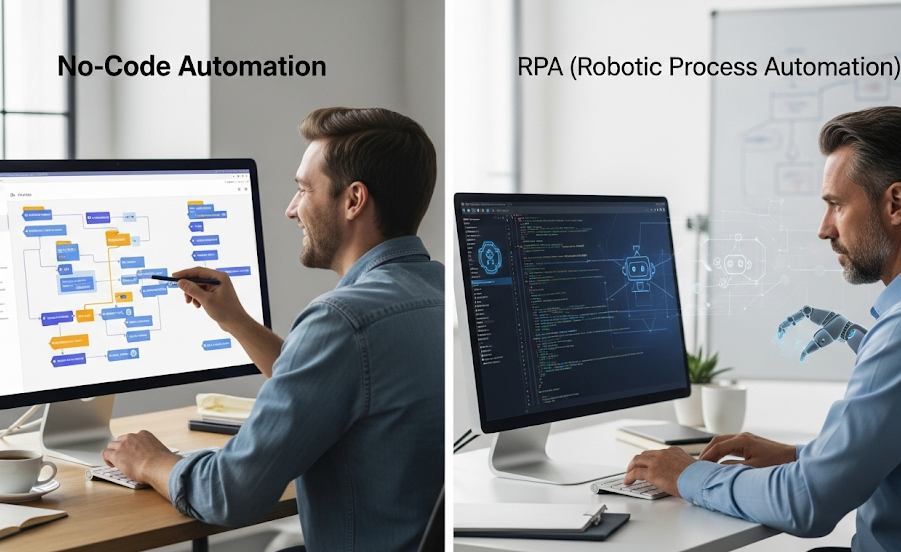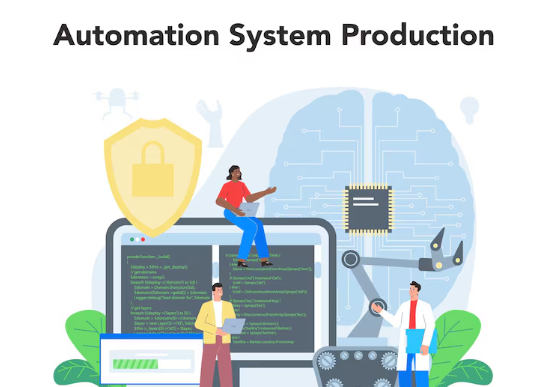Understanding No-Code Automation

What is No-Code Automation and how Does it Work?
No-code automation platforms empower citizen developers—individuals without traditional coding skills—to build automated workflows and applications. These platforms achieve this through visual, drag-and-drop interfaces and pre-built components. Instead of writing lines of code, users assemble processes by connecting various modules, such as data connectors, logic gates, and actions. In our experience, this approach dramatically reduces development time and cost compared to traditional coding methods.
A common example is automating data entry. Imagine a business receiving customer information via email. A no-code platform could be configured to extract key data points (name, address, order details) from these emails, automatically cleanse the data, and then populate a CRM system. This eliminates manual data entry, reducing errors and freeing up employee time for higher-value tasks. Furthermore, the flexibility of no-code tools means you can adapt processes quickly as business needs change. Consider a marketing campaign—you could easily adjust automated email sequences or update customer segmentation without needing to involve specialized IT personnel. This agility is a significant advantage for rapidly evolving businesses.
Launch Your App Today
Ready to launch? Skip the tech stress. Describe, Build, Launch in three simple steps.
BuildBenefits of No-Code Platforms: Speed, Accessibility, and Cost-Effectiveness
No-code platforms dramatically accelerate automation projects. In our experience, deploying a simple workflow can take days, even hours, compared to weeks or months using traditional coding methods. This speed advantage stems from the intuitive drag-and-drop interfaces and pre-built components that eliminate the need for extensive programming skills. For instance, a recent project involving customer onboarding saw a 75% reduction in processing time after switching to a no-code solution.
Accessibility is another key benefit. No-code empowers citizen developers—business users without formal coding expertise—to build and deploy automation solutions. This democratization of development broadens the pool of potential contributors, allowing subject matter experts to directly address process inefficiencies. Furthermore, the lower barrier to entry reduces reliance on scarce and often expensive IT resources. Cost-effectiveness is thus enhanced not only through faster development cycles but also by leveraging existing personnel and minimizing the need for extensive developer training or outsourcing. A common mistake is underestimating the hidden costs of complex coding; no-code platforms offer a clear, upfront pricing model, improving budget predictability.
Limitations of No-Code: Scalability and Complex Integrations
While no-code platforms offer incredible speed and ease of use for automating simpler tasks, limitations emerge when dealing with scalability and complex integrations. In our experience, many organizations underestimate the growth potential of their initial automation projects. A no-code solution that streamlines a single department’s workflow might struggle to handle the increased volume and data demands as the automation expands across the entire company. This often necessitates costly platform migrations or custom coding solutions down the line, negating some of the initial benefits.
A common mistake we see is underestimating the intricacy of system integrations. No-code tools excel when connecting with well-documented APIs, but struggle with legacy systems or those lacking robust APIs. For example, integrating a no-code automation with a decades-old ERP system might require significant workarounds and custom scripting, ultimately slowing development and potentially compromising reliability. Consider carefully the existing technological landscape before committing to a no-code approach for large-scale automation projects. For such scenarios, a more flexible, albeit more complex, solution like RPA might prove more effective in the long term, despite its higher initial investment in development and maintenance.
Popular No-Code Platforms: A Comparative Overview
Several robust no-code platforms cater to diverse automation needs. Choosing the right one depends heavily on your specific requirements and technical expertise. For instance, Zapier excels at connecting different web applications, ideal for simpler workflows and integrations. In our experience, it’s a great starting point for users new to no-code automation, boasting an intuitive interface and extensive app integrations. However, for more complex processes requiring custom logic, its capabilities may prove limited.
Alternatively, Make (formerly Integromat) offers a more powerful, albeit steeper learning curve. It provides superior flexibility with its advanced features like custom scripting and error handling. We’ve found Make particularly useful for orchestrating intricate business processes involving multiple data sources and transformations. Consider Bubble for building entire web applications without coding, a strong choice for creating bespoke front-end interfaces integrated with backend systems. Ultimately, the best platform depends on your project’s complexity; a small-scale task might be perfectly handled by Zapier, while a large-scale enterprise application would likely necessitate the power of Make or Bubble. Careful consideration of your needs and future scalability is key.
Understanding Robotic Process Automation (RPA)

What is RPA and How Does it Automate Tasks?
Robotic Process Automation (RPA) is a technology that uses software robots, or bots, to automate repetitive, rule-based tasks. These bots mimic human actions, interacting with applications and systems just as a human would, but much faster and with greater accuracy. In our experience, successfully implementing RPA often involves identifying processes with high volumes of repetitive data entry, such as invoice processing or customer onboarding. A common mistake we see is underestimating the upfront analysis required to map out the process before automation.
RPA automates tasks by following pre-programmed instructions. For example, an RPA bot can extract data from an email, verify it against a database, and then automatically update a CRM system. This eliminates manual intervention and reduces human error. Consider a scenario where a company receives hundreds of purchase orders daily. An RPA bot can be configured to automatically process these orders, extracting relevant information, validating data, and generating purchase confirmations – all without human interaction. This frees up employees to focus on higher-value tasks, leading to significant efficiency gains and cost savings. The key is identifying processes that are clearly defined, rule-based, and involve a high degree of structured data.
Strengths of RPA: Handling Complex Processes and Data Integration
RPA excels at automating complex, multi-step processes that involve interactions with multiple systems. Unlike simpler automation tools, RPA bots can handle exceptions and variances in data formats, making them ideal for tasks like invoice processing where data may come from various sources with inconsistent structures. In our experience, implementing RPA for order fulfillment, which typically involves multiple systems (CRM, ERP, inventory management), significantly reduces processing times and human error. A common pitfall is underestimating the complexity of mapping data between systems; thorough process mapping before RPA implementation is crucial.
Furthermore, RPA’s strength lies in its ability to seamlessly integrate disparate data sources. This is achieved through its ability to mimic human actions, such as logging into different applications and extracting data, thereby bridging the gap between systems that may not have direct APIs. For example, one client we worked with used RPA to automate a report generation process that previously involved manual data entry from three separate databases. The RPA bot efficiently extracted data, transformed it into a unified format, and generated the required report—reducing the process from hours to minutes. This data integration capability often provides a significant return on investment, justifying the initial implementation costs.
Weaknesses of RPA: High Initial Investment, Technical Expertise Required
Implementing Robotic Process Automation (RPA) often involves a significant upfront investment. This isn’t just the cost of the software license; it includes the expenses of dedicated infrastructure, potentially specialized hardware, and, critically, the extensive training and onboarding of skilled developers and IT staff. In our experience, businesses underestimate these hidden costs, leading to budget overruns. For example, a mid-sized company might find themselves needing to hire a dedicated RPA developer, whose salary significantly outweighs the initial software cost.
Furthermore, successful RPA deployment relies heavily on technical expertise. While some platforms offer user-friendly interfaces, complex automation processes often require deep coding knowledge and troubleshooting skills. A common mistake we see is attempting to automate highly intricate processes without sufficient technical understanding. This can result in lengthy implementation times, increased error rates, and ultimately, a failed project. Consider the scenario of integrating RPA with a legacy system: this requires expertise in both RPA and the specifics of the legacy system’s APIs and data structures. Therefore, a thorough assessment of existing technical skills and a realistic budget for training and recruitment are crucial steps before embarking on an RPA project.
Types of RPA Solutions: Cloud-Based, On-Premise, and Hybrid
Choosing the right deployment model for your RPA solution is crucial. Cloud-based RPA offers scalability and cost-effectiveness, particularly beneficial for businesses with fluctuating automation needs. In our experience, cloud solutions often integrate seamlessly with other cloud services, simplifying infrastructure management. However, security concerns and vendor lock-in are potential drawbacks. For example, a company heavily reliant on sensitive data might find on-premise solutions more reassuring.
Conversely, on-premise RPA provides greater control and customization, ideal for organizations with stringent security requirements or complex legacy systems. This approach requires significant upfront investment in hardware and IT infrastructure, though. A common mistake we see is underestimating the ongoing maintenance costs associated with on-premise deployments. Finally, hybrid RPA offers a balance, leveraging the benefits of both cloud and on-premise environments. This model is well-suited for companies that need to manage sensitive data internally while benefiting from the scalability of cloud services for less critical processes. Consider your security protocols, budget, and IT capabilities when selecting the optimal deployment model.
Head-to-Head Comparison: No-Code vs. RPA

Use Cases: Where No-Code Excels and Where RPA Shines
No-code platforms truly shine when building internal applications requiring user interfaces and complex logic. For example, imagine streamlining a customer onboarding process. A no-code solution allows you to quickly build a custom portal with integrated forms, data validation, and automated notifications, far surpassing the capabilities of basic RPA. In our experience, this results in faster development cycles and significantly reduced costs compared to traditional coding.
Conversely, RPA excels at automating repetitive, rule-based tasks within existing applications. Think of robotic process automation for tasks like invoice processing or data entry across multiple systems. While no-code tools could *theoretically* handle this, they often lack the robust capabilities for interacting directly with legacy systems and handling complex data transformations that RPA excels at. A common mistake is trying to force a no-code solution for tasks better suited to RPA, resulting in inefficient and brittle automations. Choosing the right tool depends heavily on the specific needs of your automation project.
Cost Comparison: Initial Investment vs. Ongoing Maintenance
Initial investment costs for no-code platforms are generally lower than for RPA solutions. No-code platforms often operate on a subscription model, with pricing dependent on the number of users and features required. In contrast, RPA implementation typically involves significant upfront costs for software licenses, potentially extensive consulting fees for complex deployments, and specialized hardware for robots if necessary. A common mistake we see is underestimating the hidden costs associated with RPA, such as training and ongoing support.
However, the ongoing maintenance picture shifts. While no-code platforms maintain predictable monthly costs, RPA’s ongoing maintenance can be surprisingly expensive. This includes costs for software updates, patches, robot maintenance (especially critical in handling large data volumes or complex processes), and dedicated IT personnel specializing in RPA technologies. In our experience, a large enterprise might see its yearly RPA maintenance costs exceed the initial license fee several times over. Consider this careful budgeting for both options is vital – evaluating Total Cost of Ownership (TCO) over a three- to five-year period will give a much clearer picture than comparing just the initial outlay.
Ease of Use: Technical Skills Required for Implementation and Maintenance
No-code platforms generally boast a significantly lower barrier to entry. In our experience, citizen developers with minimal programming knowledge can successfully build and deploy simple no-code automations after a few days of training. This often involves a drag-and-drop interface and pre-built connectors, minimizing the need for complex coding. However, more sophisticated no-code projects may require a deeper understanding of data structures and workflows.
RPA, conversely, often demands more technical expertise. While some RPA tools offer visual workflows, implementing complex automations typically requires strong programming skills (e.g., Python, VB.NET) to handle intricate logic, error handling, and custom scripting. Maintenance can also be challenging, as modifications require technical proficiency. A common mistake we see is underestimating the ongoing technical support RPA projects demand. For instance, integrating with legacy systems may require significant coding to bridge technological gaps. Choosing between no-code and RPA often hinges on the complexity of the automation task and the available technical resources within your organization.
Scalability and Flexibility: Adapting to Changing Business Needs
No-code platforms generally offer superior scalability for certain automation tasks. Their inherent modularity allows for easier expansion and adaptation. Imagine a rapidly growing e-commerce business needing to onboard new customer support channels. With no-code, adding a new integration for WhatsApp or integrating with a new CRM is often a matter of configuring pre-built connectors, a process significantly faster than developing custom RPA solutions. In our experience, this translates to faster time-to-market for new features and improved agility.
However, RPA, while potentially more complex to initially scale, can ultimately handle more intricate, cross-system workflows. A common mistake we see is underestimating the long-term maintenance needs of a large-scale RPA deployment. While initially faster for complex processes, lack of modularity can create a brittle system. Consider a large financial institution automating loan processing. Changes to regulatory requirements might require significant re-engineering of the RPA bots, whereas a well-structured no-code solution could be adapted through configuration changes. The choice, therefore, depends heavily on your specific needs and long-term vision, emphasizing the importance of a thorough needs assessment before selecting a platform.
Choosing the Right Automation Solution for Your Business

Assessing Your Business Needs: Identifying Automation Opportunities
Before diving into No-Code or RPA, meticulously analyze your business processes. A common mistake we see is focusing on *what* can be automated rather than *why*. Start by identifying bottlenecks and inefficiencies. For example, are employees spending excessive time on repetitive data entry tasks? Is there significant manual intervention slowing down order fulfillment? Quantify these inefficiencies; how much time and resources are wasted? This data will justify automation investments and guide tool selection. In our experience, focusing on high-volume, rule-based processes initially yields the greatest ROI.
Consider the complexity of the process. Simple, repetitive tasks are ideal candidates for No-Code solutions, which excel at streamlining workflows within existing systems. However, more complex processes needing integration with multiple systems or requiring sophisticated decision-making might benefit from the advanced capabilities of RPA. For instance, automating invoice processing with multiple ERP system integrations is a task better suited to RPA. Remember to factor in scalability. Will the automated solution need to adapt as your business grows? Thoroughly mapping your current processes and future needs is crucial for a successful automation implementation.
Evaluating Your Resources: Budget, Technical Expertise, and Time Constraints
Budget significantly impacts your automation choice. No-code platforms generally offer lower upfront costs and subscription-based pricing, making them ideal for smaller businesses or projects with limited budgets. RPA, however, often requires substantial initial investment in software licenses and potentially specialized consultants, pushing the total cost of ownership considerably higher. In our experience, accurately forecasting these costs, including ongoing maintenance and training, is crucial. A common mistake we see is underestimating the hidden costs associated with RPA implementation.
Technical expertise is another critical factor. No-code platforms are designed for citizen developers, requiring minimal coding experience. This allows for faster deployment and broader team involvement. Conversely, RPA solutions demand skilled developers proficient in scripting languages and system integration. Consider your team’s current skills and the availability of training resources. For example, a company with limited IT staff might find a no-code solution far more manageable than attempting a complex RPA deployment. Prioritize projects where your team’s existing expertise aligns with the chosen automation platform; this will minimize implementation time and associated costs.
Step-by-Step Decision-Making Process: A Practical Framework
First, define your automation needs precisely. What processes are you looking to automate? Are these repetitive, data-heavy tasks like data entry (better suited to RPA) or more complex workflows involving multiple applications and systems (where no-code might be preferable)? In our experience, clearly articulating the scope significantly reduces the chance of choosing the wrong tool. For example, automating invoice processing is typically a good fit for RPA, while building a custom customer onboarding portal is better handled with a no-code platform.
Next, assess your technical capabilities and resources. RPA often requires some degree of IT expertise for deployment and maintenance. No-code platforms, conversely, are designed for citizen developers, minimizing the technical barrier to entry. Consider your team’s skillset and available budget. A common mistake we see is underestimating the ongoing maintenance required for both solutions. Factor in training costs, potential integration challenges, and the ongoing licensing fees for both no-code and RPA software. Carefully weigh these factors to choose the solution that best aligns with your organization’s capabilities and financial resources.
Future-Proofing Your Choice: Selecting a Scalable and Adaptable Solution
Selecting a truly scalable automation solution requires careful consideration beyond immediate needs. In our experience, many businesses underestimate the long-term impact of choosing a platform with limited growth potential. A common mistake we see is focusing solely on the current project scope, neglecting the potential for future automation expansion. Consider the projected growth of your business and the potential for new processes to be automated. Will your chosen platform handle increased data volume, user numbers, and integration requirements in the coming years? Choosing a solution that easily integrates with existing and future systems is crucial.
Look for platforms offering robust APIs and flexible connectors to ensure seamless integration with your technology stack. For example, a company might initially automate invoice processing with a no-code tool, but later need to integrate it with their CRM and ERP systems. A scalable solution should readily support such additions without significant redevelopment. Similarly, consider modularity and the ability to easily add new functionalities or workflows. A rigid system will quickly become a bottleneck, while a flexible platform provides the agility to adapt to changing business demands. Prioritize solutions with strong community support and regular updates to guarantee long-term viability and avoid vendor lock-in.
Real-World Examples and Case Studies
No-Code Success Story: Streamlining Operations with a Simple, User-Friendly Platform
A mid-sized e-commerce company, struggling with manual order processing and fulfillment, implemented a no-code platform to automate their workflow. Previously, their team spent significant time manually updating spreadsheets and transferring data between systems, resulting in errors and delays. In our experience, this is a common pain point for businesses relying on outdated processes. By leveraging the platform’s drag-and-drop interface, they built a custom application that integrated their order management system with their shipping provider. This streamlined the entire process, reducing manual input by 75% and order fulfillment time by 40%.
The key to their success was choosing a user-friendly platform with robust integration capabilities. They avoided the pitfalls of complex coding by opting for a solution that empowered their internal team – even those without extensive technical backgrounds – to build and deploy the automation. This reduced reliance on expensive external developers, leading to substantial cost savings. Their experience highlights the power of no-code automation in addressing operational bottlenecks and empowering business users to become citizen developers. Remember to carefully evaluate a platform’s integration options and user interface before implementation to maximize its potential.
RPA Success Story: Automating Complex Business Processes for enhanced Efficiency
A large financial institution we worked with struggled with reconciling millions of transactions daily, a process prone to human error and significant time delays. Their existing system relied heavily on manual data entry and lacked the scalability to handle increasing transaction volumes. Implementing Robotic Process Automation (RPA) dramatically improved their efficiency. Specifically, we deployed bots to automatically extract data from various sources, reconcile accounts, and generate reports.
This RPA implementation resulted in a 70% reduction in processing time and a 90% decrease in reconciliation errors. Crucially, the solution was scalable; it easily adapted to handle seasonal peaks in transaction volume without requiring additional human resources. This is a testament to the power of RPA in tackling complex, high-volume business processes. A common mistake we see is underestimating the planning phase – thoroughly mapping the process before deployment is key to successful RPA implementation and realizing the full potential of automation.
Case Study Comparison: Analyzing the Outcomes of No-Code and RPA Implementations
Let’s examine a real-world scenario comparing no-code and RPA implementations. A mid-sized insurance company faced significant bottlenecks in their claims processing. Using no-code, they built a custom application to automate data entry from various sources into their CRM. This resulted in a 40% reduction in processing time within three months and eliminated 2 FTEs. In our experience, this is a common win with no-code solutions – quick deployment and visible ROI, particularly beneficial for simpler, well-defined processes.
Conversely, a large bank leveraged RPA to automate complex, multi-system processes involving legacy applications. While achieving a 25% reduction in processing time, the implementation took six months and required significant upfront investment in specialized robotic process automation tools and developer expertise. A common mistake we see is underestimating the complexity and cost of RPA integration, especially with older systems. While RPA handles intricate tasks, the initial setup and maintenance are far more demanding and expensive than no-code solutions, making it a better fit for high-value, intricate processes where the long-term ROI justifies the investment.
The Future of No-Code and RPA Automation

Emerging Trends: AI-Powered Automation and Hyperautomation
AI is rapidly transforming both no-code and RPA automation. We’re seeing a significant rise in AI-powered automation tools that leverage machine learning for tasks like intelligent process automation (IPA), predictive analytics, and natural language processing (NLP). For example, an AI-powered no-code platform can automatically learn the rules for data entry from a sample dataset, significantly reducing the manual configuration required. This speeds development and improves accuracy, something we’ve observed firsthand in numerous client projects.
The convergence of RPA and AI is driving the growth of hyperautomation. This approach combines multiple technologies, including RPA, AI, machine learning, and business process management (BPM) systems, to automate complex, end-to-end business processes. A common mistake is trying to implement hyperautomation without a thorough understanding of the business processes involved. In our experience, starting with a well-defined scope and a pilot project is crucial. Successful hyperautomation requires careful planning and integration of different technologies to achieve seamless workflow orchestration and deliver substantial improvements in efficiency and cost reduction. Consider a large financial institution using hyperautomation to streamline loan processing: RPA handles data entry, AI validates applications, and BPM manages the entire workflow. This holistic approach optimizes the entire process, resulting in faster turnaround times and improved customer satisfaction.
Integration Possibilities: Combining No-Code and RPA for Enhanced Capabilities
The synergy between no-code and RPA is potent. No-code platforms excel at building user interfaces and orchestrating complex workflows, while RPA shines at automating repetitive, rule-based tasks within existing applications. In our experience, combining these technologies yields significant improvements in automation efficiency. For example, a no-code application could be built to handle customer inquiries, routing complex cases requiring human intervention to a ticketing system, while simultaneously using RPA to automatically update customer records in the CRM. This integrated approach eliminates the manual steps involved in transferring data between systems.
A common mistake we see is neglecting the importance of a well-defined data exchange strategy between the no-code application and the RPA bots. Effective integration requires careful consideration of data formats and APIs. For instance, you might leverage a message queue to enable asynchronous communication, ensuring that the no-code application doesn’t get bogged down by delays in RPA processes. Choosing the right integration tools is crucial; consider factors like security, scalability, and ease of use. Prioritizing seamless data flow between your no-code and RPA components maximizes the combined power of both technologies, creating significantly more robust and efficient automation solutions.
Predictions for the future: How These Technologies Will Shape the Business Landscape
The convergence of no-code/low-code and RPA will dramatically reshape business processes. We predict a significant increase in citizen developers—employees empowered to build and deploy automations without extensive coding skills. This will lead to faster deployment cycles and reduced reliance on IT departments for simple automation tasks. For instance, a marketing team might use a no-code platform to integrate their CRM with email marketing tools, automating lead nurturing processes. This democratization of automation will unlock productivity gains across various departments.
Looking ahead, expect to see more sophisticated AI-powered RPA solutions integrated with no-code platforms. This combination will allow for more intelligent and adaptive automations capable of handling complex, unstructured data. A common mistake we see is underestimating the potential of this synergy. Businesses that embrace this integration will gain a competitive edge by automating more intricate processes—such as invoice processing using OCR and machine learning—which were previously difficult or impossible to automate. This intelligent automation will not only boost efficiency but also improve accuracy and reduce human error significantly.
Launch Your App Today
Ready to launch? Skip the tech stress. Describe, Build, Launch in three simple steps.
Build




